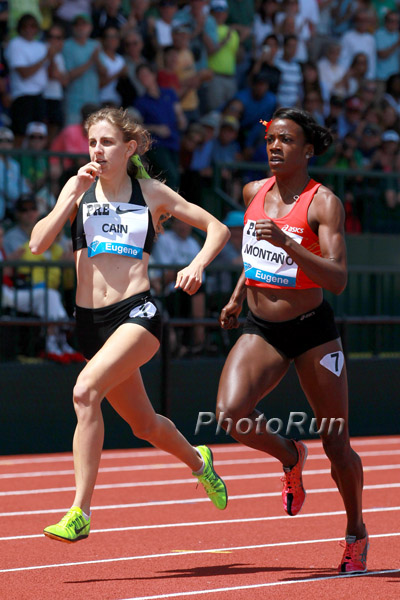On the eve of the USA Track & Field Championships, we have this piece from David Hunter, one of our key columnists.
Raising Cain On The Big Stage
Mary Set To Race USA’s Best In Des Moines
June 16, 2013
There can be little doubt that a major highlight of 2013 track & field – just now reaching the full stride of the outdoor season – has been the spectacular emergence of high school distance phenom Mary Cain. The 17 year old high school junior – virtually unknown to all but the most  observant track & field fans before embarking on her indoor record-breaking tear in January – has stunned and charmed the sport in a way not seen since innocent, pig-tailed Mary Decker rewrote the record book way back in the 70’s.
observant track & field fans before embarking on her indoor record-breaking tear in January – has stunned and charmed the sport in a way not seen since innocent, pig-tailed Mary Decker rewrote the record book way back in the 70’s.
On the eve of the USATF Outdoor Track & Field Championships – which will result in the assemblage of the USA team which will compete at the World Championships this August in Moscow – several questions about Mary Cain beg for answers.
In which championship meet event(s) will Cain compete?
It may seem unusual to ask this question about any track & field athlete, much less a high-schooler. But remember: almost nothing about Mary Cain, the track athlete, is usual. Cain – who has claimed 7 national high school and national junior records since the beginning of the year – has exceptional middle distance skills. She has already achieved the Worlds coveted “A” standard in the 800 off of the strength of her 1:59.51 5th place finish at the Prefontaine Classic earlier this month. Only two other American women [Brenda Martinez (1:58.18); Alysia Montaño (1:59.43)] have done so. In addition, the young middle distance star – with a 1500 performance of 4:04.62 in the Oxy High Performance meet last month – joins a group of just six other American female athletes [led by Jenny Simpson (4:02.85) and Salazar-coached Treniere Moser (4:02.80)] who have achieved the Worlds “A” standard in the metric mile. Earlier this month, Cain posted a 5000 time of 15:45.46 which – while not meeting either the Worlds “A” or “B” standard – nonetheless set new national high school and junior records. While Cain could compete in any one or more of these three events in Des Moines, the conventional wisdom is that Cain will toe the line in the 1500 – seen as the event in which she has the best chance to compete for a Moscow berth.
When it comes to running rounds, is Cain able?
Cain’s splashy performances since the beginning of the year have all been in one-event races. Racing in rounds is a whole different animal. Can the rising middle distance star navigate through a Day One preliminary 1500 and come back on Day Three with her “A” game ready to go in a 1500 final? A review of her non-rounds 2013 performances suggests she can. Cain has shown she can compete off varied paces. In the indoor national’s mile race, Cain was patient with a near-pedestrian tempo that hovered just below 6:00 mile pace before – using her vernacular – “killing it in” with a final 400 of 58.59 – at altitude! – to capture easily her first national title. Conversely, she also kept her cool in the Pre 800 when the pace was hot from the starting gun. Letting others – some who later paid dearly – go out hard, Cain employed a Wottle-esque approach, ran even splits, and was rewarded with a 5th place finish in the “A” standard time of 1:59.51.
While Cain is a skillful racer off different tempos, she performs particularly well when she can make her competitors uncomfortable with her formidable finishing speed. With apologies to My Fair Lady, the reign of Cain involves dishing out the pain. And the high-schooler – whose unorthodox running style belies her potent kick – can dish it out. Her proven sub-2:00 800 speed is to be respected in the type of tactical affair the women’s 1500 final is likely to be.
What will be Cain’s post-high school education/athletic plans?
While this is not a question of immediate moment, speculative talk about Cain’s post-high school plans abounds even now. Given the successful and apparently-comfortable athlete-coach relationship she shares with Alberto Salazar – her personal coach since last fall – many tea-leaf readers see Cain ultimately matriculating to the University of Oregon with its revered track and field heritage, its top flight facilities, its rabid fan base – and its proximity to Coach Salazar. Could we see a reprise of the initially-doubted, but ultimately wildly successful troika of U of O / Athlete / Salazar which elevated Galen Rupp?
Another theory sees Cain following an Allyson Felix-like pathway. Some suggest NCAA competition may be altogether bypassed by Cain – whose times this spring have bettered the winning marks in the NCAA women’s 800 and 1500. Proponents of this theory suggest that Cain might choose to link an NCAA-less college education with an immediate post-high school professional track career. One exotic East Coast offshoot of this theory would have Cain – who Salazar has identified to be an excellent student – heading to an institution like Princeton where she would: (i) remain close to home; (ii) have daily contact with Princeton coach and proven middle-distance groomer Jason Vigilante who could collaborate with Salazar to guide Cain’s track fortunes; and (iii) pursue an Ivy League education.
Will Cain be able to retain the poise she has displayed throughout her meteoric 2013 rise?
It is to be expected that questions would be asked about a high-schooler’s ability to remain composed, to handle the pressure of competing in a national championship meet with an opportunity to win a title and gain a berth on the national team that will compete in Moscow. But Cain – trained and handled superbly by Salazar – has demonstrated she can handle the bright lights and the expectations that come with competing at the highest levels of the sport.
While Cain’s composure plays a big role, Salazar’s masterful handling should not be overlooked and cannot be over-emphasized. There were more than a few whispers of skepticism when Salazar first embraced coaching after his career as a world class distance runner concluded. But virtually no such doubts remain today. Firmly established as an innovator, a focused taskmaster, and a skilled handler of personalities, Salazar has been able to guide his athletes – including Cain – away from some of the training and racing pitfalls that he himself was unable to sidestep as an elite athlete. Knowing that in Cain he is dealing with an unmatched distance running talent but remembering that she is, after all, a 17-year old school girl, the savvy coach has done an excellent job of keeping it light and breezy. Mixing up his protégé’s racing distances, sending her out to perform at a variety of different venues, and always reminding her that it is about “just competing,” Salazar has deftly deflected away from Cain the type of overbearing pressure that often can come from an undue emphasis on winning and fast times. We have all witnessed the stunning results: Cain – who not coincidentally is nonetheless ringing up fast times and capturing an occasional victory – is an eager and joyful athlete who can’t wait for her next opportunity to “compete.”
And so there are a myriad of questions swirling around Mary Cain as the U.S. Outdoor Track & Field Championships are set to commence later this week. And while the meet itself will provide answers to many, others will require additional time before answers emerge. But before the championships even begin, one thing is certain. When
Mary Cain steps out onto Drake’s big blue oval, she will be ready to compete.
~Dave Hunter






















